Visiting the Grand Canyon in August is a great time to visit. August is a busy time to visit but the crowds are starting to arrive especially toward the end of the month.
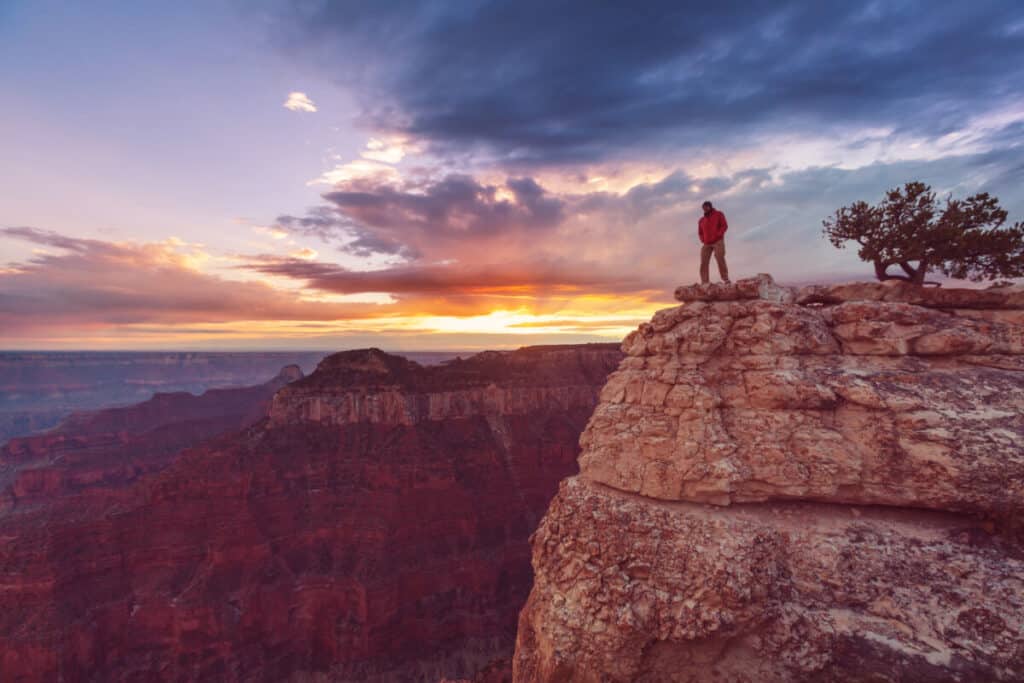
I’ve included all of the things to do in the Grand Canyon in August and tips and tricks for visiting. You can also use the Grand Canyon self guided tour to learn more about the Grand Canyon when you visit.
Weather in the Grand Canyon in August
In May, the daytime maximum temperature is 103 degrees Fahrenheit (31 degrees Celsius), while the overnight minimum is 75 degrees Fahrenheit (23 degrees Celsius). The Grand Canyon covers a huge area and each section has a varied temperature.
Thank you for supporting this website written by an American. This post may contain affiliate links. This means I earn a small commission on these links at no extra cost to you.
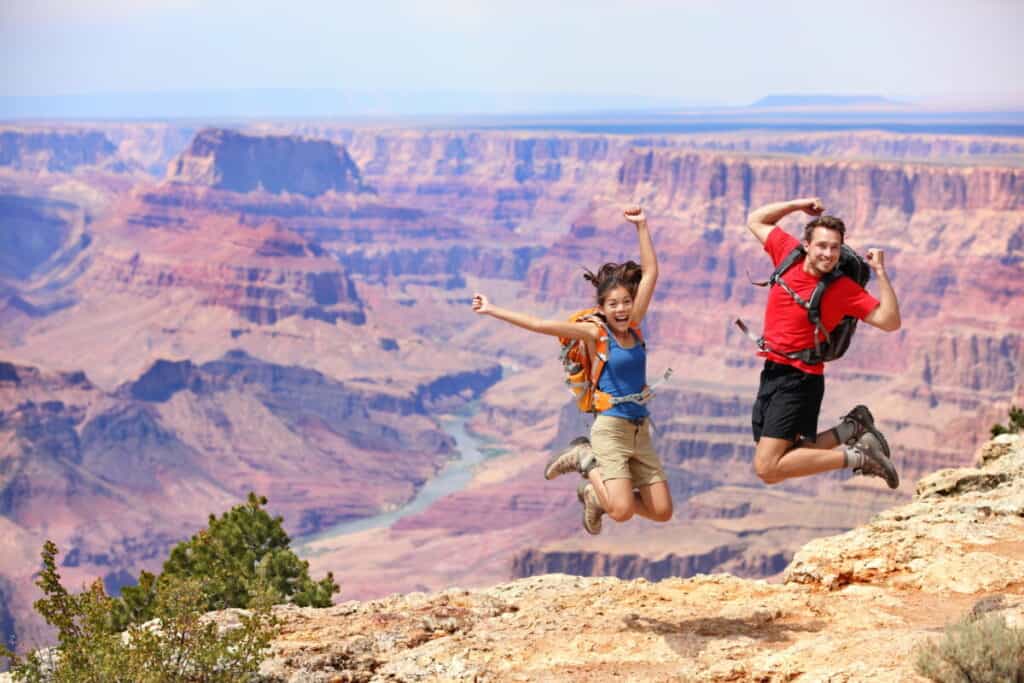
National Park Entrance Fees
To enter the National Parks, you’ll need to pay an entrance fee or have a National Parks Pass also known as American the Beautiful Pass.
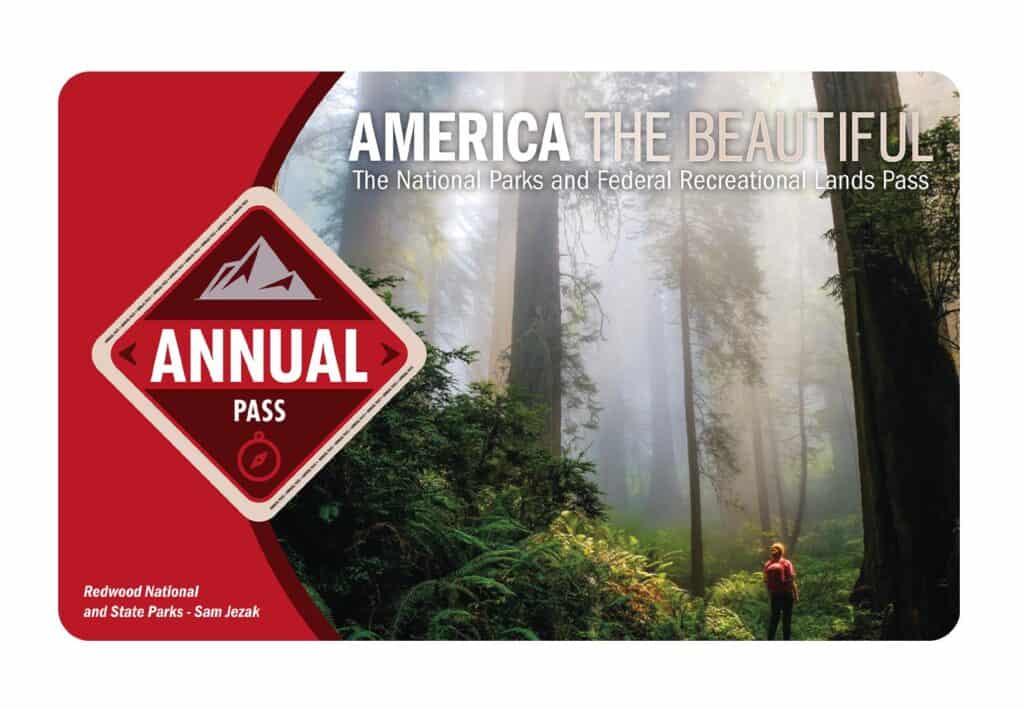
It costs $80 for a yearly America the Beautiful Pass. This gives you access to all national parks and federal areas that charge fees. The America the Beautiful Pass is well worth it!
I purchased my first one in 2016 and it’s such a money-saver! Plus 10% of sale proceeds go to the National Park Foundation.
Tips for Visiting Grand Teton National Park
Grand Canyon National Park is perfect for outdoor enthusiasts. There is something for everyone on this list and for different fitness levels. Also, note that it is dry and hot (in the summer), and make sure you know what you are getting into before you start. Here are a few tips for visiting the Grand Canyon:
- Bring a reusable water bottle and lots of water! Remember you are in the sun and you will need to drink lots of water. I love my LifeStraw Filtered Water Bottle. I can refill this bottle anywhere and it comes with a carabiner to connect it to my daypack.
- Check the Weather – days over 100 degrees are very common. Make sure to check.
- Hiking boots or sandals that will protect your feet! I love good shoes. I need all the support and help I can get. I actually love these sandals for hiking and also love these hiking boots.
- Bring hiking poles for balance and to protect your knees. I know many experienced hikers (and even amateur ones) think that hiking poles are for old people who lose their balance. Actually, hiking poles can help when going down steep inclines or when scrambling over rocks. They are great to hike with even for the most experienced hiker.
- Wear a sunhat. I feel like this whole post is about how high you are in the mountains and how much closer you are to the sun but it is so true. At elevation, you are closer to the sun and more likely to burn. Wear sun protection such as a sun hat and sunscreen.
- Be aware of the wildlife. This is the Southwest and you will need to watch out for snakes and other wildlife such as moose or a bear. Please stay away from wildlife and do not feed them. I recommend carrying bear spray as well.
- Start Early – If you want to avoid the traffic and the heat you will need to start your hike early. That way it will be nice and cool and the smog will not affect you either.
- Leave no trace. If you are new to the concept of Leave No Trace it is all about preserving the environment to ensure it is in the same or better condition when you leave it. This means that you should stick to the trails and carry out everything that you carried in. This is a great explanation of the Leave No Trace principles!
- Water shoes are great for water hikes– If you don’t have a pair, I highly suggest it as they are affordable. I have an article on the pros and cons of several pairs of water shoes.
- Bring Bug Spray and a snack: Be sure to bring everything you need including a snack like a protein bar plus BUG SPRAY.
Where to stay near Grand Canyon National Park
The Grand Canyon makes for a great weekend escape. Fresh air, beautiful scenery and being in nature does a world of good for the soul. I recommend staying as close to the park as possible and even treating yourself with a cabin with a spa pool to relax at night.
- There are lots of fantastic Airbnbs near the Grand Canyon. I have made a list of the best airbnbs around the park wherever you decide to stay. You can also check out my post on Where to Stay near the Grand Canyon to find the perfect hotel for any budget.
If you are taking a road trip remember to reserve a car in advance using Discover Cars .
15 Things to do in the Grand Canyon in August
Grand Canyon South Rim: Self-Guided Tour
See a natural wonder of the world in person on this self-guided driving tour of the Grand Canyon’s South Rim.

This self-guided driving tour takes you to all the best vistas, hikes, and attractions along Grand Canyon’s South Rim and tells you the secret history behind this famous landscape. Walk the scenic South Rim Trail, catch a sunset at Mather Point, and much more.
Guided Range Tour
Using the free park ranger programs is a fantastic way to maximize your time at Grand Canyon National Park.

Park rangers are knowledgeable about the park and offer various opportunities to learn about the canyon. They are easily identifiable with their flat straw hats. Rangers provide a wide choice of educational programs with a fantastic view, whether it be a brief 20-minute discussion about Grand Canyon geology or a half-day trip into the canyon to Cedar Ridge!
Some guided ranger programs you can take are Ranger Geology Talks and Walks, Junior Ranger Programs, Kolb Studio Tour Ranger Programs, and History Walk Ranger Programs.
The Grand Canyon’s South Rim Village has the most ranger program options annually. Ranger presentations and walks are available at Phantom Ranch, Desert View, and the North Rim. Although the selection of programs varies from year to year and season to season, you can nearly always rely on finding the following shows:
Grandview Point
On Desert View Drive, this particular location is where most people choose to stop. That’s because it has the most regal name of any Grand Canyon viewpoint location.
About midway between Desert View Point and Grand Canyon Village lies Grandview Point. Another sizable parking lot with a fantastic observation point is this pull-over location.
The Grand Canyon may be seen in a full 180-degree panorama from this location, and you can also get a magnificent view of the Colorado River bends to the east.
The Grandview Trail, one of the steepest hiking trails in Grand Canyon National Park, begins at Grandview Point.
Mather Point
Mather Point, one of the most visited canyon overlooks, is situated immediately next to the official Grand Canyon Visitor Center.
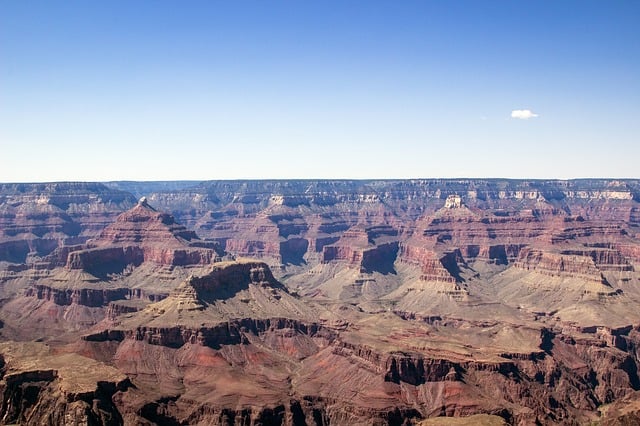
On the way to Grand Canyon Village from the west, take Desert View Drive. Here, you can leave your car for free in a few sizable, designated parking areas.
The genuine Mather Point is a broad, roomy platform perched above a striking rock feature. Visitors can enjoy some of the most stunning views of the Granite Gorge and the Grand Canyon’s amazing 7119-foot (2170-meter) vertical drop from top to bottom.
This Grand Canyon observation point offers views of Bright Angel Canyon and nearby landmarks like the Isis Temple, Cheops Pyramid, and Zoroaster Temple. Demaray Point, Bradley Point, and Summer Butte can all be seen from here as well.
Desert View Watchtower
Some of the most breathtaking views of the Grand Canyon may be seen in the Desert View area. And that’s only the start. All ages can enjoy a historical, artistic, architectural, and Native American cultural experience at Desert View.
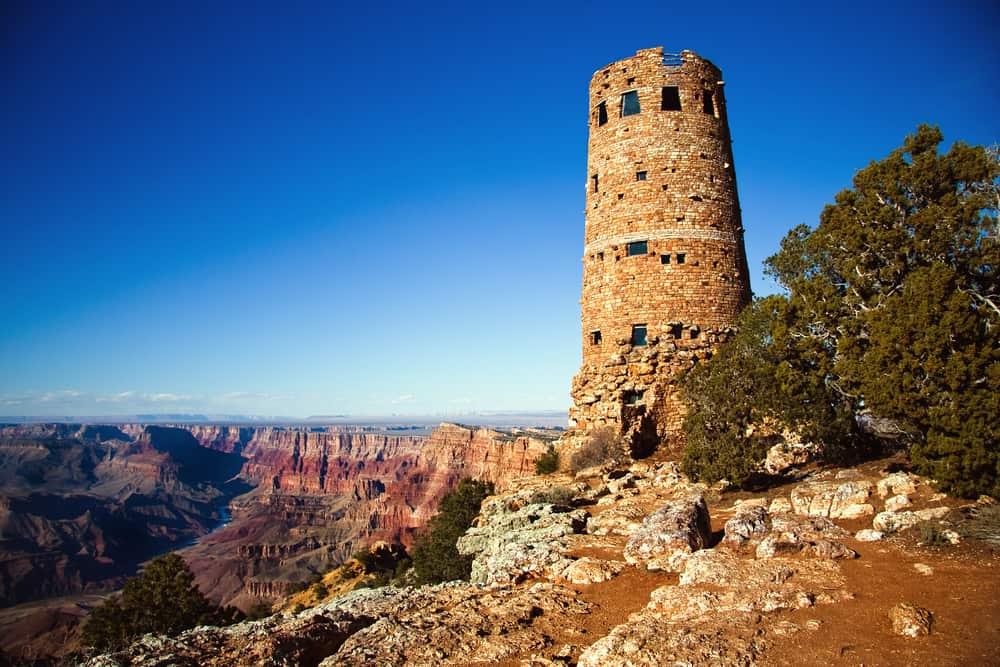
The Watchtower, designed by famous architect Mary E. J. Colter and constructed in 1932, serves as the focal point of Desert View. A Hopi artist created murals that cover this famous structure, which was adorned in the style of traditional Native American watchtowers. If you’re interested in local culture, you may also get a glimpse into the lives of the Pueblo Indians, who lived in this area more than 800 years ago, at the adjacent Tusayan Museum and Ruins.
Everything you require is close at hand once you arrive at Desert View. There is a general store where you can purchase food and other essentials. A deli with wholesome, southwest-inspired meal selections is located within.
Another location to refuel, replenish fluids, or satisfy your sweet craving with hand-scooped ice cream, smoothies, and more is the Desert View Trading Post.
The Trading Post also provides the chance to buy authentic things made by Native American artisans, crafters, and artists. There is even a separate space where young children can engage in enjoyable activities while learning about the rich cultural legacy of the locality.
Regardless of your viewpoint, Desert View offers much more than just breathtaking scenery.
Bright Angel Viewpoint
The Bright Angel Trail is one of the most well-liked lengthy hikes in the Grand Canyon because of its breathtaking views.
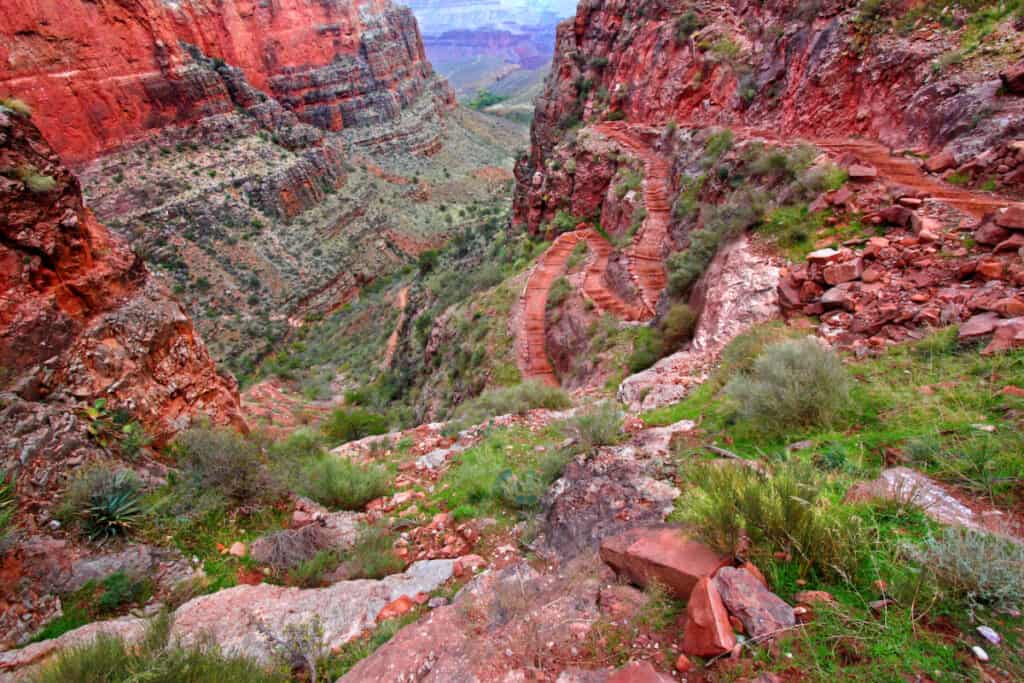
This long, challenging trail starts not far from Grand Canyon Village and drops more than 4300 feet to the Colorado River’s source.
The engraved trails of the Bright Angel Trail are probably visible if you visit one of the other viewpoints on this list. You might even see a few pack mules or some enthusiastic hikers!
The average grade on this track, which is extremely steep, is roughly 10%. In actuality, spending the effort to trek the Bright Angel Trail is well worth it if you want to experience the Grand Canyon.
Yaki Point
Another popular point is Yaki Point. The views are spectacular.
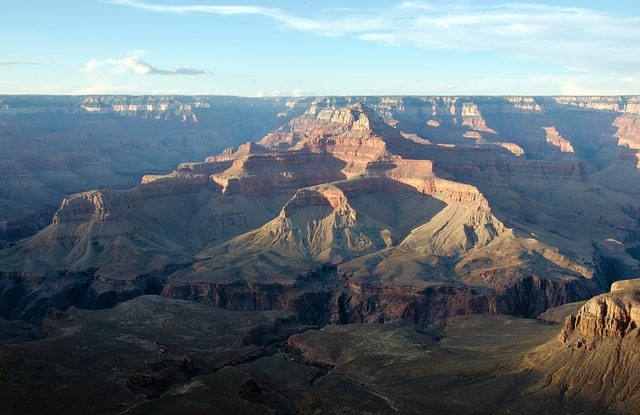
Access is now only possible on foot, by parking on the main road at a nearby picnic spot, or by shuttlebus since the tiny parking area at the rim was deemed too small to handle the growing number of people a few years ago.
On the Kaibab Trail Route, which also serves Pipe Creek Vista and the Canyon View Information Center at Mather Point, Yaki is the stop that is furthest to the east. The South Kaibab Trailhead, which is halfway up the side road, is likewise subject to the restriction.
Yaki Point’s views contrast significantly with those of the popular trio of Grandeur, Yavapai, and Matthew Points, which all sit on the same peninsula and overlook similar terrain features. The view to the west includes O’Neill Butte, Cedar Ridge, the terminus of the Bright Angel Trail, a stretch of the Tonto Trail, and a good portion of the South Kaibab Trail.
On the other hand, in the distance (on the North Rim), the lengthy drainage of Clear Creek is surrounded by numerous tall buttes and mesas. Cremation Creek can be seen flowing beneath another long red ridge centered on Newton Butte.
Hopi Point
From the Grand Canyon Village, you’ll head east to start the legendary Hermit’s Road Drive. The rim is followed by a lovely woodland road that leads to several lookout sites and viewing areas.
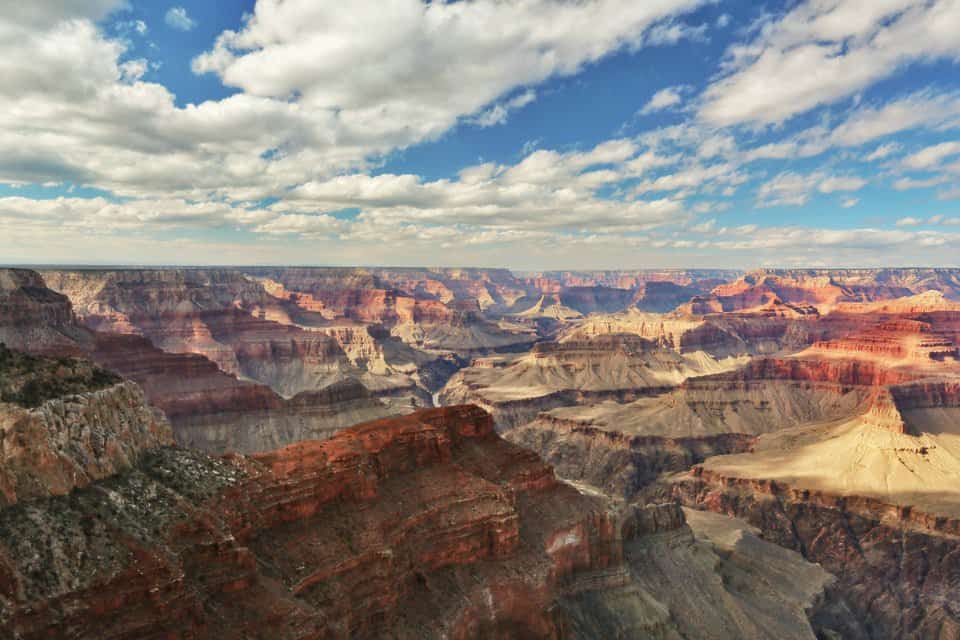
Hopi Point, located about two miles distant, is one of Hermit’s Road Drive’s most stunning viewpoint locations. This well-liked location for a canyon overlook offers breathtaking views of the canyon walls next to it as well as one of the five first glances of the river to the west (there are five altogether at Hopi Point).
Also, because of its extended position, Hopi Point provides some of the best Grand Canyon sunset views. You must visit the canyon to believe how the sun illuminates it!
Similar to the majority of pull-over sites, this one has enough room for parking and even restrooms.
Explore the Trail of Time
The 13-mile (19-kilometer) Rim Trail hike along the South Rim of the Grand Canyon is one of the highlights of taking a tour bus in Las Vegas. Tour bus passengers can explore the canyon at their speed and do it safely and conveniently by using the Rim Trail.
Visitors are rewarded with breathtaking scenery and geological knowledge as the walk follows the edge of the Canyon. This trail offers walkers a way to see the Canyon regardless of their level of fitness or age, despite rising only to an elevation of 200 feet and being heavily shaded.
Start at one of the parking areas in Grand Canyon Village for the quickest access to the Grand Canyon Trial of Time. To get to either end of the path, you can board a free shuttle bus. Starting at the Yavapai Geology Museum, take a stroll westward from the geological present to the past of the Canyon. Whether you wish to move from west to east or from the past to the present, you should start at the Verkamps Visitor Center.
You can take a South Rim walking tour and discover more about the interesting geological history of the Grand Canyon by traveling by tour bus in Las Vegas, such as one of the opulent vehicles offered by Grand Canyon Destinations.
You will find the information fascinating and instructive regardless of whether you have a fervent interest in the topic or just a passing fancy.
Helicopter Ride down into the Grand Canyon
At the Grand Canyon, helicopter tours are accessible all year long. You should experience the vistas of the canyon covered with snow in December.
Even though there are many excursions available, the Grand Canyon Helicopter Tour is among the best. During the 45-minute flight, you will fly over the South Rim and the Kaibab National Forest.
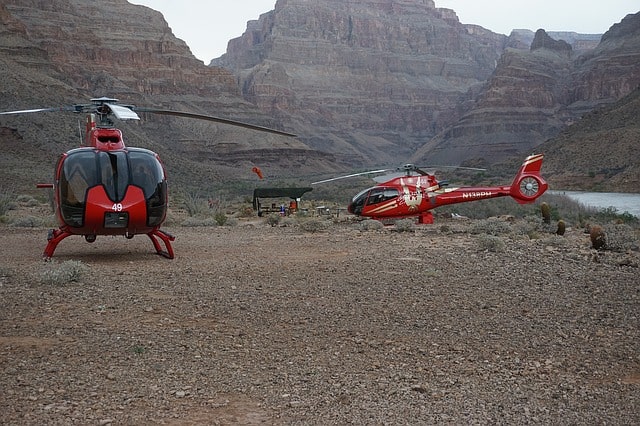
Experience the canyons by looking down into them on a helicopter tour or simply viewing them from a vantage point.
These helicopter rides, though perhaps a bit pricy, are well worth it and will provide you with priceless memories.
Experience the Spirit Helicopter Tour if you want to make this a trip you’ll never forget. The most popular and affordable helicopter tour leaving from the South Rim is this one.
The Spirit Tour, which flies over the Painted Desert, Kaibab National Forest, and—best of all—the Dragon Corridor, the widest and deepest section of the Grand Canyon, gives you some of the be
Yavapai Point
Especially if you’ve already stopped at Ah Aah Point or Yaki Point, head west towards Yavapai Point if you’re going to walk the Rim Trail from Mather Point.
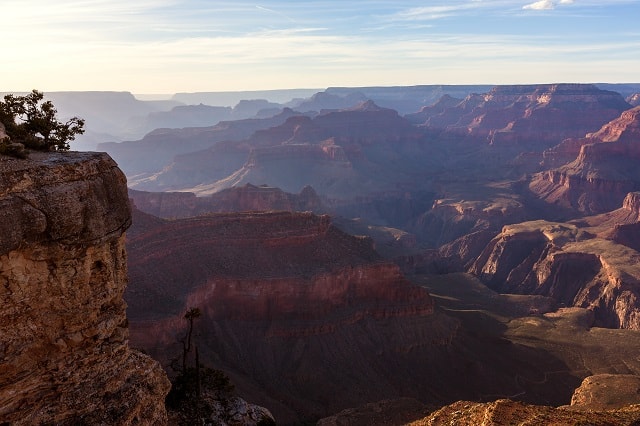
Yavapai Point is another breathtaking vantage point. You may find the Yavapai Geology Museum here (Yavapai Observation Station). Visitors can discover all about the formation and geological past of the Grand Canyon in Arizona at this tiny, enclosed museum.
When you realize how distant the North Rim perspectives are from here, it’s also an excellent place to get your bearings and be once more astounded by the enormity.
There is also a shuttle bus that runs from the Grand Canyon Visitor Center near Mather Point to Yavapai Point and the Geology Museum for those who are less interested in hiking the Rim Trail.
Hermit’s Road Drive
The historic Hermit’s Road drive is a gorgeous, historic trip with many vantage points you won’t want to miss, rather than just one specific sight.

Hermit’s Road Drive starts in Grand Canyon Village and extends 7 miles (11.2 km) to the west to Hermit’s Rest.
You can stop at Maricopa Point, Powell Point, Hopi Point, Mohave Point, The Abyss, Monument Creek View, Pima Point, and Hermit’s Rest along Hermit’s Road.
The Hermit Trail, which is twisting and steep, sits at the end of this road if you’re up for it. The Hermit Creek Campsite and the Hermit Rapids on the Colorado River are reached via this drawn-out but beautiful hike that descends the Cathedral Stairs.
Plateau Point
Although the Plateau Point Trail, which is 1.5 miles long, is not particularly challenging, the entire adventure—from the South Rim Trail to the beautiful viewpoint—is 12 miles round trip.
Just past the ranger station and mule corrals at the northern end of Indian Garden, the Plateau Point Trail begins. After crossing Garden Creek and leaving the shade behind, continue west along the Plateau Point Trail. Follow the Tapeats sandstone’s contours as it crosses a dry plateau and a series of ravines. There is no shade here; instead, cacti and other vegetation cover the generally level desert terrain.
Turn right to head northeast at the intersection of the West Tonto Trail and the fork. From here, you can almost directly ascend across the Tonto Platform to the viewpoint. To get to a flattop rock and viewing platform, pass a water tank and mule hitching post.
See if you can spot rafters navigating Horn Rapid while admiring the breathtaking scenery (so-called by the two huge protruding rocks at the beginning of the rapid, making this an easy place to get stuck).
Kids should not play near the edge! This trail allows mules to watch out for their droppings.
Shoshone Point
Just west of milepost 246 on Desert View Drive, there is a gate and an unmarked parking area where the Shoshone Point Trail begins. The peaceful trail is a mile-long, mostly level dirt road that gains only 100 feet. Hiking through a ponderosa pine-covered forest will allow you to cross the plateau.
The bend around a loop, where there are chairs, grills, mule hitching posts, and pit toilets, is after a mile. You can rent the covered pavilion for events, but you don’t need a permit to simply go to the overlook.
Although there are beautiful views of the eastern Grand Canyon from this rim, thrill seekers continue to the extreme edge of Shoshone Point. A fall could be fatal due to loose rock and small ledges, so take caution.
Look at the fascinating rock formation at the spot that resembles a mushroom and a headstone. Find out if you can spot the Hance Rapids, Desert View Tower, Vishnu Temple, Horseshoe Mesa, and other notable locations.
Enjoy the quiet of this deserted gem before returning to the parking lot. In addition, many people come here to view sunsets (bring a headlamp for the hike back).
Ooh Aah Point
There are many pull-over locations and picnic areas along Desert View Drive, including Moran Point, Duck on a Rock Viewpoint, and Shoshone Point, where you can stop to take in the Grand Canyon as you proceed towards Mather Point and the Visitor’s Center.

Many of these stops have comparable vistas. But if you want a little different picture of the Grand Canyon, think about making the 1.8-mile (2.9-km) roundtrip climb up the South Kaibab Trail to Ooh Aah Point. If you want to avoid the crowds around the rim but don’t want to commit to a strenuous full-day trail, this is a fantastic option.
It’s an out-and-back track, so you’ll be climbing and descending (especially for the first 1/4 to 1/2 mile) 700 feet of elevation on the South Kaibab Trail to Ooh Aah Point. But overall, it’s not that difficult.
Ooh Aah Point’s perspective is distinct from the others on this list since it is located inside the Grand Canyon, as opposed to many of the others, which are around the rim. When you reach the sign for the South Kaibab Trail on Yaki Point Road, pull over and turn left to access the trail.
Recent Posts
15 Tips for Visiting the Grand Canyon in September – 2023 Ultimate Guide
Visiting the Grand Canyon in September is a great time to visit. September is a busy time to visit but the crowds are starting to arrive especially toward the end of the month. I’ve included...
15 Tips for Visiting the Grand Canyon in July – 2024 Ultimate Guide
Visiting the Grand Canyon in July is a great time to visit. July is a busy time to visit but the crowds are starting to arrive especially toward the end of the month. I’ve included all of...
